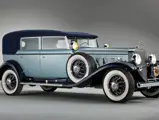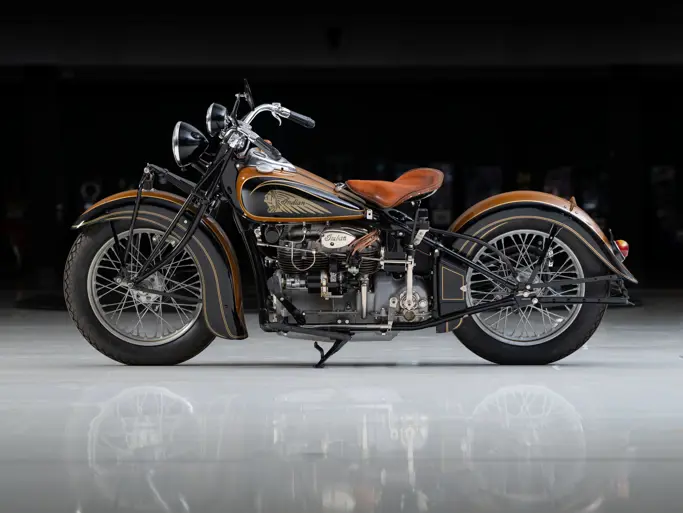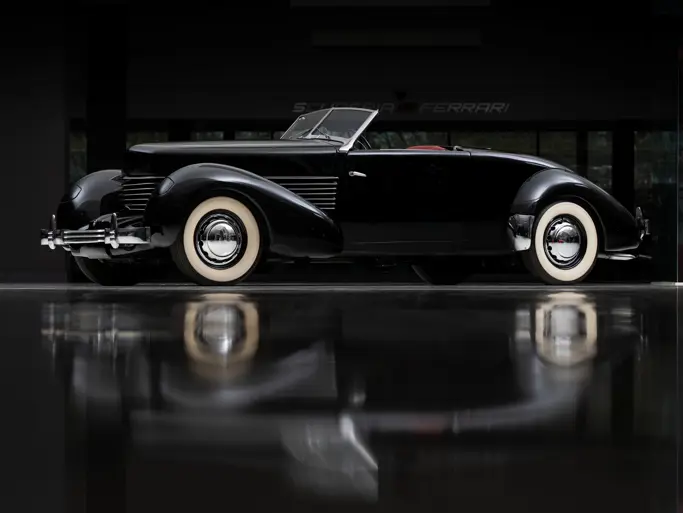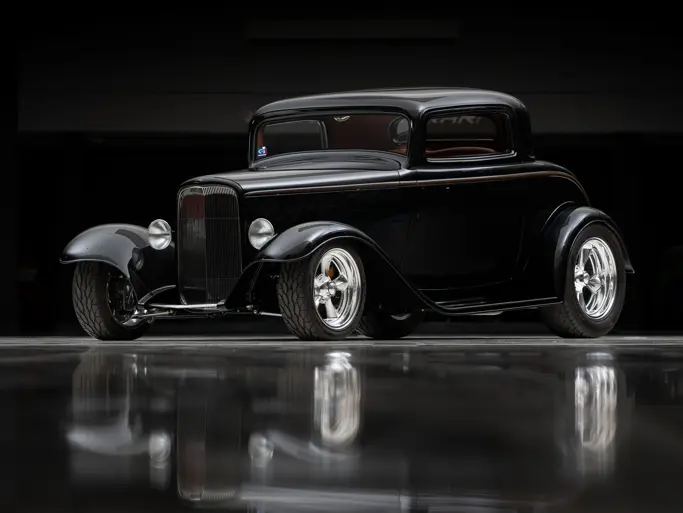Villa d'Este 2011
1930 Cadillac V-16 Convertible Berline by Saoutchik
{{lr.item.text}}
€307,500 EUR | Sold
 | Cernobbio, Italy
| Cernobbio, Italy
{{internetCurrentBid}}
{{internetTimeLeft}}

175 hp, 452 cu. in. overhead valve V-16 engine with three-speed synchromesh transmission, solid front axle and torque tube rear axle, four-wheel semi-elliptic leaf springs and four-wheel power assisted brakes. Wheelbase: 3,750 mm (148")
- Cadillac’s extraordinary sixteen-cylinder tour de force
- Unique, rare, one-off Saoutchik coachwork with several special features
- Remarkable full-length sunroof
- Superb Fran Roxas restoration
- Multiple awards, including two class awards at Pebble Beach
In 1930, Cadillac stunned the fine-car market with the introduction of its breathtaking new sixteen-cylinder models. The cars instantly catapulted Cadillac, which until then had been a mid-priced car, to the head of the luxury class.
Designed by Owen Nacker, Cadillac’s V-16 was an engineering tour de force, incorporating several unique features. Its 45-degree cylinder bank angle and overhead-valve design kept the engine narrow, while the external manifolding provided good access. Cadillac’s V-16 was the first engine compartment to be styled, with all the wiring hidden and plenty of gleaming, polished aluminium, shining porcelain and a pair of beautiful valve covers with brushed aluminium ridged surfaces.
One-off coachwork
Unlike most builders of fine cars, Cadillac discouraged custom body builders, preferring to direct the business to Fleetwood, the company’s in-house coachbuilder. Only a very few chassis were made available for other builders, so most were forced to buy complete cars, remove the factory body and install their own designs. That, in fact, is what Saoutchik, the extravagant Parisian coachbuilder, did with this outstanding Cabriolet Berline design. Established in 1906, Saoutchik’s work was exceptional, respected for its workmanship and the quality of its fittings and finishes. The art and style of his work, frequently daring and outrageous, were patronised by the wealthiest of Parisians and exhibited at the world’s most exclusive concours events.
This particular one-of-a-kind body was built with a unique sunroof which opens over the length of both the driver and passenger compartments, sliding down into the rear body as a roll-top desk does. A glass sunroof, which is over the passenger compartment in the closed position, aligns with the rear window in the open position, allowing full use of the window in either position!
Although technically closed, the body’s clever design allows most of the advantages of both open and closed bodies. With the sunroof retracted, the centre pillars are removable, like a convertible sedan, creating an almost completely open body. And yet, by simply sliding the sunroof closed, installing the pillars and rolling up the windows, the car offers all the advantages of a closed body.
The car’s fittings are particularly elaborate. A full set of Stephen Grebel lights are fitted. Sold only to custom coachbuilders, these are extremely rare and very valuable by themselves. The upholstery and woodwork in the interior of the car is very elaborate, in keeping with the latest Paris fashions. A full set of instrumentation graces the rear compartment.
Provenance
The car was sold new in mid-1930, complete with its Saoutchik coachwork replacing the original Cadillac body. At some point in the post-war period, the car was found having been abandoned for several years in a Paris garage. Not long afterwards, it was bought by French automobile dealer Johnny Thuysbaert. Repairs were carried out in 1964 by the Francis Workshops near Paris, following which it was featured in an article in the August issue of France's Auto Journal.
The next owner was M. Serge Pozzoli, former editor of France's Fanatique de l'Automobile, who stored it in a warehouse at Avenue Jean-Jaures in Paris, where it came to the attention of Hubert Le Gaillais, who subsequently bought the car and began showing it at various meets in and around Paris in the late '60s and '70s.
In the late 1980s, the car was returned to the United States, where it was completely restored to the highest standards by respected restorer Fran Roxas of Alsip, Illinois for Fred Weber of St. Louis, Missouri. During restoration, this remarkable body was removed from the Cadillac chassis on which it was originally built – a chassis that was initially bodied by Cadillac as a roadster. Roxas then put the Saoutchik body onto chassis 700979, another correct V-16 chassis, originally fitted with a Fleetwood four-door sedan body and complete with its original engine number 700979. It is interesting that this chassis was originally ordered new by C.F. “Boss” Kettering, the creator of the self starter, Delco, and a leading GM engineer who went on to develop the Parade of Progress, making it, in itself, an historically important car.
After the car was completed, it was purchased by Detroit-area real estate developer Bernie Glieberman, with noteworthy results. Major awards included a Class Award at Pebble Beach in 1991 and at Meadow Brook in 1995 where it won Best in Class and the Engineering in Excellence Trophy. The present owner acquired the automobile in January 2001.
In its current ownership, this outstanding V-16 has won awards at the Pebble Beach Concours, with yet another Class Award, and Amelia Island, where it received the trophy for Most Elegant Closed Car, as well as at Palos Verdes and Newport Beach. Recently in the care of noted restorers Alan Taylor and Mosier Restorations, the car benefited from both a cosmetic upgrade and a mechanical freshening in order to prepare the car for touring as well as show purposes.
Few V-16s were coachbuilt; this one-off design features many innovative elements, making it a truly unique automobile. With its no-expense-spared restoration and maintenance, it offers a truly unique opportunity, featuring the very best in American Classic Era, cutting-edge engineering with the most luxurious of European coachwork.
175 cv, motore V-16 a valvole in testa di 7.406cc, cambio manuale sincronizzato a tre marce, assale anteriore e posteriore rigido, balestre semi-ellittiche e freni servo-assistiti sulle quattro ruote. Passo: 3.750 mm
- Straordinario motore Cadillac a 16 cilindri
- Carrozzeria in esemplare unico di Saoutchik con numerosi particolari speciali
- Bellissimo tetto apribile a tutta lunghezza
- Eccezionale restauro di Fran Roxas
- Vincitrice di numerosi premi, comprese due vittorie di classe al Concorso di Pebble Beach
Nel 1930, la Cadillac entrò di prepotenza nel mercato delle vetture di categoria superiore presentando modelli mozzafiato dotati del nuovo motore a 16 cilindri. Il nuovo modello catapultò immediatamente la Cadillac, che fino ad allora aveva prodotto solo vetture di classe media, al vertice del mercato delle vetture di lusso.
Progettato da Owen Nacker, il motore Cadillac V-16 era un capolavoro di ingegneria e presentava numerose soluzioni uniche. L'angolo di 45 gradi tra le bancate dei cilindri e la soluzione delle valvole in testa avevano permesso di ottenere un motore stretto e facilmente accessibile grazie ai collettori posti all'esterno. Quello del Cadillac 16 cilindri fu il primo vano motore ad essere valorizzato anche sotto l'aspetto stilistico con l'impianto elettrico nascosto e con grande abbondanza di alluminio lucidato e porcellana splendente e con bellissimi coperchi delle valvole alettati in alluminio spazzolato.
Carrozzeria unica
Al contrario della maggior parte dei costruttori di automobili di lusso, la Cadillac scoraggiava i carrozzieri indipendenti, preferendo affidare l'incarico di costruire le carrozzerie speciali a Fleetwood, la propria carrozzeria interna. Pochissimi telai furono messi a disposizione degli altri carrozzieri, costringendoli così ad acquistare vetture complete dalle quali rimuovere la carrozzeria standard per poi sostituirla con quella da loro creata. E fu quello che fece appunto anche Saoutchik, l'estroso carrozziere parigino, con questa eccezionale Cabriolet Berline. Nata nel 1906, la Saoutchik era rinomata per l'eccellente fattura delle sue carrozzerie e la qualità degli accessori e delle finiture. L'arte e lo stile delle sue creazioni, spesso audaci ed eccessive, erano particolarmente apprezzati dai parigini più ricchi e le vetture erano esibite ai concorsi più esclusivi del mondo.
Questa carrozzeria unica è dotata di un esclusivo tetto apribile che scopre per tutta la loro lunghezza il posto guida e quello dei passeggeri, per poi scomparire all'interno della parte posteriore della carrozzeria, come una vera capote deve fare. Un tettuccio di vetro, posto sopra la zona passeggeri nella posizione chiusa, è allineato con il vetro posteriore nella posizione aperta, permettendo quindi la vista verso l'esterno in entrambe le posizioni!
Sebbene sia tecnicamente una carrozzeria chiusa, la sua intelligente progettazione la rende perfettamente fruibile anche come carrozzeria aperta. Quando il tetto è aperto, i montanti centrali possono essere rimossi, come sulle berline convertibili, creando una carrozzeria quasi completamente aperta. Al contrario, semplicemente chiudendo il tetto, reinstallando i montanti e tirando su i finestrini, si ottengono tutti i vantaggi di una carrozzeria chiusa.
Gli accessori sono scelti con cura particolare, come il set completo di fanali Stephen Grebel. Venduti solo ai carrozzieri, questi fanali sono particolarmente rari e preziosi. La tappezzeria e la boiserie all'interno sono particolamente curate, in linea con le più attuali tendenze stilistiche parigine del tempo. La parte posteriore è completata da un set completo di strumenti.
Storia
Dotata della carrozzeria Saoutchik in sostituzione dell'originale carrozzeria Cadillac, la vettura fu venduta nuova a metà del 1930. Negli anni seguenti la fine della Seconda Guerra Mondiale, la vettura fu ritrovata, abbandonata da diversi anni, in un garage di Parigi. Non molto tempo dopo, fu acquistata dal commerciante francese di automobili Johnny Thuysbaert. Alcune riparazioni furono effettuate nel 1964 dalla Francis Workshops, vicino Parigi, dopo le quali la vettura fu illustrata in un articolo sul numero di Agosto della rivista francese Auto Journal.
Il proprietario successivo fu Serge Pozzoli, editore della rivista francese Fanatique de l'Automobile, che la ricoverò in un magazzino in Avenue Jean-Jaures a Parigi, dove fu vista da Hubert Le Gaillais, che la comprò e la esibì in vari raduni nell'area di Parigi fra la fine degli anni Sessanta e gli anni Settanta.
Alla fine degli anni Ottanta, la vettura fu riesportata negli USA dove fu completamente restaurata ai più alti livelli dal noto restauratore Fran Roxas di Alsip, nell'Illinois, per Fred Weber di St. Louis, nel Missouri. Durante i lavori, questa bellissima carrozzeria fu rimossa dall'originale telaio Cadillac per il quale era stata costruita (e che originariamente era dotato di una carrozzeria roadster) e fu montata sul telaio n. 700979, un altro telaio V-16, originariamente nato con carrozzeria berlina di Fleetwood e ancora dotato del suo motore originale n. 700979. E' da notare che questo telaio era stato ordinato nuovo da C.F. “Boss” Kettering, l'inventore del motorino d'avviamento Delco, un importante progettista della GM che sviluppò la "Parade of Progress": già questo la rende una vettura importante dal punto di vista storico.
Alla fine del restauro, la vettura fu acquistata da Bernie Glieberman, un immobiliarista della zona di Detroit, che ottenne notevoli successi in diversi concorsi, compresi una vittoria di classe a Pebble Beach in 1991, e un'altra vittoria di classe e l'Engineering in Excellence Trophy a Meadow Brook nel 1995.
L'attuale proprietario ha acquistato la vettura nel gennaio 2001 e in seguito ha ottenuto altri riconoscimenti in vari concorsi come Pebble Beach, ancora un premio di classe, Amelia Island, il trofeo per la Vettura Chiusa Più Elegante, Palos Verdes e Newport Beach. Affidata recentemente ai noti restauratori Alan Taylor and Mosier Restorations, la vettura ha beneficiato di alcuni lavori alla carrozzeria e agli interni e di una revisione meccanica, in attesa di essere utilizzata su strada o in concorsi.
Pochi esemplari della V-16 hanno ricevuto carrozzerie personalizzate; questo esemplare unico presenta numerosi elementi innovativi che ne fanno una vettura veramente esclusiva. Con il suo restauro senza limiti di spesa e l'accurata manutenzione, rappresenta un'opportunità veramente unica di acquistare una vettura che accoppia il massimo dell'avanguardia progettuale dell'Epoca Classica americana con una delle più lussuose carrozzerie europee.





